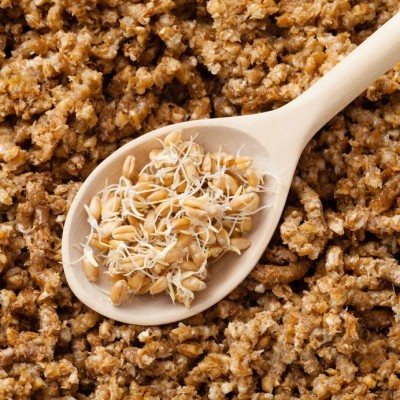
Sprouted Grain Bread
Also known as Sprouted Bread
What is Sprouted Grain Bread?
Sprouted grain bread is made from a flour or mash created from sprouted cereal grains. The sprouting process involves the germination of cereal kernels and releases nutrients and organic compounds naturally trapped in the grain structure.
- Sprouted flour or mash creates bread that has extra sweetness and flavor with a longer shelf life.
- These breads are popular because of their health benefits. They are a readily digestible product and are often made with less sugar than standard bakery products.
Origin
The production of the first sprouted grain breads is an ancient tradition. In the past, standard grain harvesting practices around the world involved leaving grain in the field after harvest. While waiting to be threshed (separating the seed from the shaft), the grain would absorb moisture.
Back in the 2nd century BC, a Jewish monastic group known as the Essenes developed the earliest recipes and techniques for sprouted grain breads.1
How does it work?
Sprouting occurs when grain seeds/kernels are soaked and rinsed. This activates a natural process called germination. Germination begins with water uptake by the grain seed (imbibition or long hydration process), and ends with the emergence of the embryonic axis, usually the radicle, through the structures surrounding it which causing the outer shell of the grain to crack.2
The resulting sprouted grain is then ready for milling and baking applications. Due to its high enzymatic activity, the increased amount of simple sugars can be consumed by yeast during fermentation. This creates increased bread volume.
Nutrition
There are several benefits regarding sprouted bakery products:
- Sprouted grain breads have been reported to have increased levels of antioxidants, tocopherols, thiamin (vitamin B1), riboflavin (vitamin B2), pantothenic acid (vitamin B5), biotin (vitamin B7), folate (vitamin B9), and fiber.3
- Sprouting grains for baking applications increases phytase activity. Phytase is an enzyme that breaks down phytic acid, an organic anti-nutrient compound that binds to minerals/micronutrients such as calcium, magnesium, iron and zinc, and reduces their absorption in the small intestine. The degradation of phytic acid increases the bioavailability these minerals.4
Commercial Production
The process begins with sprouting the grains, under closely monitored temperature and moisture conditions, to start the germination process . This germination is achieved by steeping/soaking grains with water to raise their moisture level. This step usually takes 24-48 hours.
There are two methods for commercially producing bakery products using sprouted grains:
- The first method stops at the soaking step. After this, the grains are germinated, dried/kilned, and then milled into sprouted flour that can then be shipped to bakeries.
- The second method processes the sprouted (swollen) grains using cold extrusion or mechanical pressing/crushing. This results in a dough-like product or a paste, ready to be mixed with other ingredients, fermented, and baked in the bakery. This type of sprouted product is normally labeled “flourless.”
Cereal grains, such as wheat, millet, barley, spelt, or a mix of these, are most commonly used. However, sometimes legumes such as soybeans or lentils are used for sprouts as well.
Application
Unlike 100% whole wheat flour that often leaves bread with a bitter taste, sprouted flour introduces a unique flavor and sweetness. In most cases, little to no sugar is used in sprouted grain bread products.
Sprouted grain flours have a low water activity level compared to standard flour. However, research has shown that sprouted flour increases dough stability during mixing, decreases proof time and increases loaf volume.3
Some sprouted grain flours have double the shelf life of conventional whole wheat flour. However, storage is still needed in a dry, cool place.5
FDA regulation
There are currently no FDA requirements on sprouting or what constitutes a “sprout.” However, the agency does provide guidelines to reduce the risk of contamination, including production, treatment, condition, storage and transportation.6
References
- Bob’s Red Mill. Using Sprouted Grains, 29 May 2010, https://www.bobsredmill.com/blog/healthy-living/using-sprouted-grains/.
- Bewley, J.D. “Germination.” Seeds: Physiology of Development, Germination and Dormancy, Springer Science+Business Media, LLC, 2013, pp. 133–134.
- Richter, K., K. Christiansen, and G. Guo. “Wheat Sprouting Enhances Bread Baking Performance.” Cereal Foods World Volume 59–5 (2014), pp. 231–33.2
- Snider, M. and Liebman, M. “Calcium Additives and Sprouted Wheat Effects on Phytate Hydrolysis in Whole Wheat Bread.” Journal of Food Science, Volume 57 (1992), pp. 118–120.
- Ariyama, T., and K. Khan. “Effect of Laboratory Sprouting and Storage on Physicochemical and Breadmaking Properties of Hard Red Spring Wheat.” Cereal Chemistry Volume 67 (1990), pp. 53–58.
- Center for Food Safety and Applied Nutrition. “Guidance Documents & Regulatory Information by Topic – Draft Guidance for Industry: Compliance with and Recommendations for Implementation of the Standards for the Growing, Harvesting, Packing, and Holding of Produce for Human Consumption for Sprout Operations.” U S Food and Drug Administration Home Page. 19 Jan. 2017. www.fda.gov/Food/GuidanceRegulation/GuidanceDocumentsRegulatoryInformation/ucm510578.htm.

